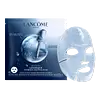What's inside
What's inside
 Key Ingredients
Key Ingredients

 Benefits
Benefits

 Concerns
Concerns

 Ingredients Side-by-side
Ingredients Side-by-side

Water
Skin ConditioningGlycerin
HumectantBifida Ferment Lysate
Skin ConditioningButylene Glycol
HumectantCaprylic/Capric Triglyceride
Masking1,2-Hexanediol
Skin ConditioningSucrose
HumectantLactobacillus Ferment
Skin ConditioningTocopherol
AntioxidantSodium Benzoate
MaskingMadecassoside
AntioxidantHydrolyzed Wheat Protein
Skin ConditioningSodium Dehydroacetate
PreservativeSodium Succinate
BufferingPhenoxyethanol
PreservativePhenyl Trimethicone
Skin ConditioningAdenosine
Skin ConditioningFaex Extract
Skin ConditioningPEG-60 Hydrogenated Castor Oil
EmulsifyingArginine
MaskingEthylhexylglycerin
Skin ConditioningPolyacrylate-13
Allantoin
Skin ConditioningPolyisobutene
Polysorbate 20
EmulsifyingSalicyloyl Phytosphingosine
Skin ConditioningLimonene
PerfumingPentylene Glycol
Skin ConditioningLinalool
PerfumingCeratonia Siliqua Gum
EmollientCarrageenan
Sorbitan Isostearate
EmulsifyingDisodium EDTA
Potassium Chloride
Citronellol
PerfumingPotassium Hydroxide
BufferingMethionine
Skin ConditioningPotassium Sorbate
PreservativeGlycine
BufferingParfum
MaskingWater, Glycerin, Bifida Ferment Lysate, Butylene Glycol, Caprylic/Capric Triglyceride, 1,2-Hexanediol, Sucrose, Lactobacillus Ferment, Tocopherol, Sodium Benzoate, Madecassoside, Hydrolyzed Wheat Protein, Sodium Dehydroacetate, Sodium Succinate, Phenoxyethanol, Phenyl Trimethicone, Adenosine, Faex Extract, PEG-60 Hydrogenated Castor Oil, Arginine, Ethylhexylglycerin, Polyacrylate-13, Allantoin, Polyisobutene, Polysorbate 20, Salicyloyl Phytosphingosine, Limonene, Pentylene Glycol, Linalool, Ceratonia Siliqua Gum, Carrageenan, Sorbitan Isostearate, Disodium EDTA, Potassium Chloride, Citronellol, Potassium Hydroxide, Methionine, Potassium Sorbate, Glycine, Parfum
 Reviews
Reviews

Ingredients Explained
These ingredients are found in both products.
Ingredients higher up in an ingredient list are typically present in a larger amount.
Pentylene glycol is typically used within a product to thicken it. It also adds a smooth, soft, and moisturizing feel to the product. It is naturally found in plants such as sugar beets.
The hydrophilic trait of Pentylene Glycol makes it a humectant. As a humectant, Pentylene Glycol helps draw moisture from the air to your skin. This can help keep your skin hydrated.
This property also makes Pentylene Glycol a great texture enhancer. It can also help thicken or stabilize a product.
Pentylene Glycol also acts as a mild preservative and helps to keep a product microbe-free.
Some people may experience mild eye and skin irritation from Pentylene Glycol. We always recommend speaking with a professional about using this ingredient in your routine.
Pentylene Glycol has a low molecular weight and is part of the 1,2-glycol family.
Learn more about Pentylene GlycolPhenoxyethanol is a preservative that has germicide, antimicrobial, and aromatic properties. Studies show that phenoxyethanol can prevent microbial growth. By itself, it has a scent that is similar to that of a rose.
It's often used in formulations along with Caprylyl Glycol to preserve the shelf life of products.
Water. It's the most common cosmetic ingredient of all. You'll usually see it at the top of ingredient lists, meaning that it makes up the largest part of the product.
So why is it so popular? Water most often acts as a solvent - this means that it helps dissolve other ingredients into the formulation.
You'll also recognize water as that liquid we all need to stay alive. If you see this, drink a glass of water. Stay hydrated!
Learn more about Water